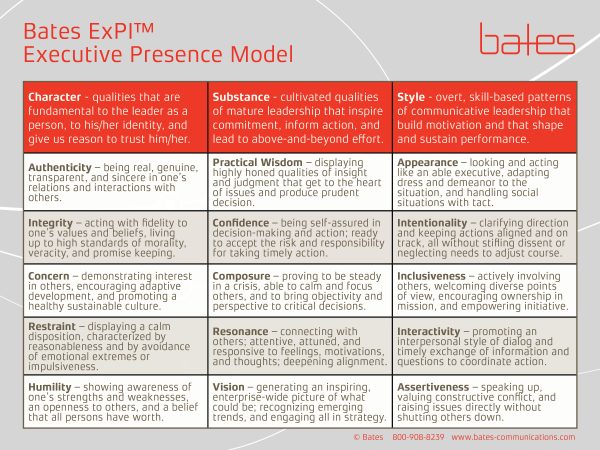 In today’s complex business landscape, leadership is no longer just about making decisions or commanding authority. A vital component of successful leadership is executive presence—the ability to inspire confidence, project authority, and lead effectively. But at the core of executive presence lies a less tangible yet critical skill: emotional intelligence (EI). The ability to understand and manage emotions—both one’s own and those of others—plays a fundamental role in how leaders project gravitas, communicate, and connect with others.
In today’s complex business landscape, leadership is no longer just about making decisions or commanding authority. A vital component of successful leadership is executive presence—the ability to inspire confidence, project authority, and lead effectively. But at the core of executive presence lies a less tangible yet critical skill: emotional intelligence (EI). The ability to understand and manage emotions—both one’s own and those of others—plays a fundamental role in how leaders project gravitas, communicate, and connect with others.
In this article, we’ll explore why emotional intelligence is essential for executive presence and examine insights from prominent authors and researchers on the subject and share with you their work so that you can choose your own adventure on your own leadership development. If you are a leader who wants to work with one of theglasshammer.com’s executive or leadership coaches on this very topic of executive presence or gravitas- we have a range of professional coaches to choose from. Book here for an exploratory chat with Nicki our head coach and she can tell you more about pricing and who in the cadre would best suit your needs (and level).
What is Executive Presence?
Executive presence is often described as the combination of gravitas, communication skills, and appearance that enables a leader to command attention and influence others. Here are the academics and authors who have opined over the past twenty years on how to have executive presence and what it actually is since for many years, it was merely a thinly guised call for women to assimilate to legacy male behavior.
Sylvia Ann Hewlett, in her book “Executive Presence: The Missing Link Between Merit and Success,” defines executive presence as “the ability to project gravitas—confidence, poise under pressure, decisiveness; communication—speaking skills, assertiveness, and the ability to read an audience; and appearance.” While these elements are crucial, they are deeply influenced by a leader’s emotional intelligence.
Daniel Goleman, one of the foremost authorities on emotional intelligence, argues that leadership success is more about emotional intelligence than technical skills. In his seminal work, “Emotional Intelligence: Why It Can Matter More Than IQ,” Goleman explains that emotionally intelligent leaders can manage their own emotions, navigate social complexities, and make better decisions. All of these skills are fundamental to projecting executive presence.
Goleman’s emotional intelligence framework comprises four domains and twelve competencies, which directly enhance executive presence:
- Self-awareness: The ability to recognize and understand your own emotions. Leaders who are self-aware can stay calm under pressure, a critical aspect of gravitas.
- Self-management: The ability to control or redirect disruptive emotions. This helps leaders project confidence and poise, even in challenging situations.
- Social awareness: Including the competencies of empathy and organizational awareness, it’s the ability to understand the emotions of others and reading the dynamics at play within groups. Empathy enhances communication and helps leaders build strong relationships.
- Relationship management: Proficiency in managing relationships and building networks. This is key to engaging stakeholders and influencing decisions.
Gravitas and Emotional Intelligence
Gravitas—the ability to command respect and inspire trust—is one of the most important elements of executive presence. However, true gravitas doesn’t come from being domineering or aloof. It comes from a place of self-assurance, empathy, and calmness, all of which are rooted in emotional intelligence.
Rebecca Newton, author of “Authentic Gravitas: Who Stands Out and Why,” highlights that authentic gravitas is about “the ability to lead and inspire others while remaining true to yourself.” This authenticity comes from emotional intelligence, particularly self-awareness and empathy. Leaders who are in tune with their emotions and those of others are better able to manage conflict, make thoughtful decisions, and create a sense of trust and stability—all hallmarks of gravitas. Theglasshammer.com endorses this source and is a book that is often recommended when we coach executives looking for some practical “how to” ideas as it doesn’t focus on superficial traits like power posturing or image management. Instead, Newton argues that true gravitas comes from within and is grounded in substance, credibility, and the ability to connect with others.
Key Themes:
- Gravitas Redefined: Newton redefines gravitas as the ability to be taken seriously, inspire trust, and influence others, not through dominance or authority, but through authenticity and meaningful contributions.
- Authenticity Over Image: The book emphasizes that authentic gravitas doesn’t come from mimicking traditional leadership traits or projecting a certain image. Instead, it is about being genuine, confident in your knowledge, and willing to listen and engage with others openly.
- Building Gravitas: The author outlines how leaders can develop gravitas by aligning their actions with their values, building emotional intelligence, and developing deeper expertise in their areas of focus.
- Connection and Credibility: Newton highlights that gravitas also involves the ability to build strong relationships and communicate effectively. Leaders with authentic gravitas engage with people at all levels, show empathy, and remain composed under pressure.
- Impact and Influence: True gravitas leads to lasting influence. Leaders who embody this trait inspire others, foster collaboration, and create environments where people are more willing to follow their guidance and vision.
Communication and Emotional Intelligence
Effective communication is another core pillar of executive presence. Leaders with strong emotional intelligence are better communicators because they can tailor their message to resonate with different audiences and navigate difficult conversations with ease.
Amy Cuddy, in her book “Presence: Bringing Your Boldest Self to Your Biggest Challenges,” emphasizes that leaders who exhibit presence communicate in a way that makes others feel understood and valued. Emotional intelligence enhances a leader’s ability to read the room, adapt their communication style, and respond with empathy—critical skills for projecting authority and trustworthiness.
Emotional intelligence also helps leaders master nonverbal communication, a key aspect of executive presence. Research by Carol Kinsey Goman, author of “The Silent Language of Leaders,” shows that emotionally intelligent leaders use body language effectively to project confidence, openness, and authority. Goman argues that “leaders who are aware of the nonverbal cues they send and how they align with their words are perceived as more authentic and trustworthy.”
Empathy and Connection
While gravitas and communication help leaders project authority, empathy is what enables them to connect with others. Executive presence is not just about being seen as capable; it’s about making others feel heard, understood, and respected. This is where emotional intelligence truly shines.
Emotional Intelligence as the Foundation of Executive Presence
While executive presence is often associated with outward behaviors—how one speaks, dresses, or carries themselves—its true foundation lies in emotional intelligence. Leaders who possess high emotional intelligence can project gravitas, communicate effectively, and connect with others on a deeper level. They are self-aware, empathetic, and composed under pressure, all of which are essential traits for cultivating executive presence. By cultivating emotional intelligence, leaders can develop a more authentic, impactful executive presence that resonates with others and drives lasting success.
By Nicki Gilmour, executive leadership coach and founder and CEO of theglasshammer.com


